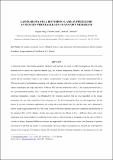Laminar oxy-fuel diffusion flame supported by an oxygen-permeable-ion-transport membrane
Author(s)
Kirchen, Patrick; Hong, Jongsup; Ghoniem, Ahmed F
DownloadJ.Hong et al. Combustion and Flame 160 2013 704-717.pdf (2.247Mb)
PUBLISHER_CC
Publisher with Creative Commons License
Creative Commons Attribution
Terms of use
Metadata
Show full item recordAbstract
A numerical model with detailed gas-phase chemistry and transport was used to predict homogeneous fuel conversion processes and to capture the important features (e.g., the location, temperature, thickness and structure of a flame) of laminar oxy-fuel diffusion flames stabilized on the sweep side of an oxygen permeable ion transport membrane (ITM). We assume that the membrane surface is not catalytic to hydrocarbon or syngas oxidation. It has been demonstrated that an ITM can be used for hydrocarbon conversion with enhanced reaction selectivity such as oxy-fuel combustion for carbon capture technologies and syngas production. Within an ITM unit, the oxidizer flow rate, i.e., the oxygen permeation flux, is not a pre-determined quantity, since it depends on the oxygen partial pressures on the feed and sweep sides and the membrane temperature. Instead, it is influenced by the oxidation reactions that are also dependent on the oxygen permeation rate, the initial conditions of the sweep gas, i.e., the fuel concentration, flow rate and temperature, and the diluent. In oxy-fuel combustion applications, the sweep side is fuel-diluted with CO[subscript 2], and the entire unit is preheated to achieve a high oxygen permeation flux. This study focuses on the flame structure under these conditions and specifically on the chemical effect of CO[subscript 2] dilution. Results show that, when the fuel diluent is CO[subscript 2], a diffusion flame with a lower temperature and a larger thickness is established in the vicinity of the membrane, in comparison with the case in which N[subscript 2] is used as a diluent. Enhanced OH-driven reactions and suppressed H radical chemistry result in the formation of products with larger CO and H[subscript 2]O and smaller H[subscript 2] concentrations. Moreover, radical concentrations are reduced due to the high CO[subscript 2] fraction in the sweep gas. CO[subscript 2] dilution reduces CH[subscript 3] formation and slows down the formation of soot precursors, C[subscript 2]H[subscript 2] and C[subscript 2]H[subscript 4]. The flame location impacts the species diffusion and heat transfer from the reaction zone towards the membrane, which affects the oxygen permeation rate and the flame temperature.
Date issued
2012-12Department
Massachusetts Institute of Technology. Department of Mechanical EngineeringJournal
Combustion and Flame
Publisher
Elsevier
Citation
Hong, Jongsup, Patrick Kirchen, and Ahmed F. Ghoniem. ":Laminar oxy-fuel diffusion flame supported by an oxygen-permeable-ion-transport membrane." Combustion and Flame 160:3 (March 2013), pp. 704-717.
Version: Author's final manuscript
ISSN
00102180